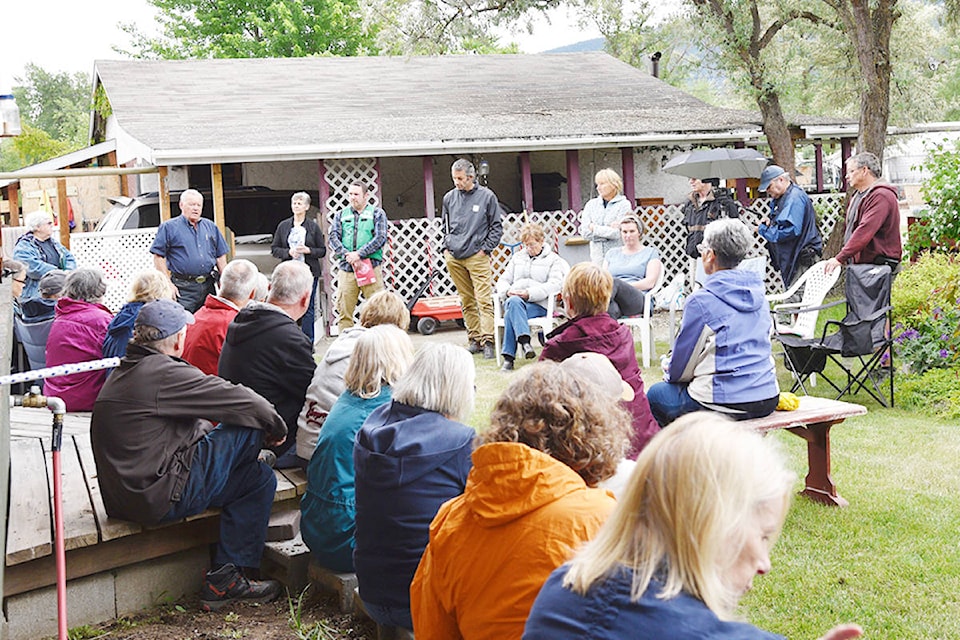There were lots of questions about flood mitigation, clean-up and rebuilding at a series of public meetings held last week in flood-affected neighbourhoods.
The Regional District of Kootenay Boundary organized three meetings last week: on Friday in North and South Ruckle and on Saturday afternoon in Johnson Flats. The meetings were a chance for residents to ask questions of officials as well as receive updates.
One of the most notable updates to come out of the meetings was that the RDKB has now hired a flood recovery manager. This person is expected to be with the RDKB during the beginning of the recovery process, and will be assisted by a local deputy recovery manager, someone from the community who will be present long-term.
According to the RDKB, the recovery manager is Steve Newton, formerly of Emergency Management BC. Emergency Operations Centre director Chris Marsh said he is optimistic about Newton’s connections in both disaster recovery and provincial agencies.
Marsh also gave a general overview of the flooding. He noted there had been no loss of life during the flooding, and commended the work of first responders and staff.
The recovery team is currently being staffed, he said, and that team will guide the recovery process after the EOC is disbanded.
Another update comes in the form of an “unmet needs committee” being formed, which will look at places that help has fallen short (disaster assistance or insurance, for example) and how to fill those gaps.
The Resilience Centre is set to close June 27, he added, but the Red Cross is expected to be in the Boundary long term.
Other highlights include some details on the financial requests the RDKB has made of the province: a $300,000 request last week, over and above what the RDKB said has been $8-million in requests for direct response.
At the meeting in Johnson Flats on Saturday, Marsh said they are estimating costs of $15-20-million to recover from flooding.
Representatives from the City of Grand Forks (including several councillors and the mayor), Disaster Financial Assistance, the Ministry of the Environment and Interior Health were present. More representatives are expected to be present at tonight’s (Wednesday’s) public meeting.
Resident reactions to the meetings varied by neighbourhood, ranging from calm to outright anger. Residents at the Ruckle meetings expressed significant concern about soil contamination, and showed significant displeasure at the Ministry of the Environment’s current plan for soil testing, which asks residents to fill out an online questionnaire. Results will be collated and analyzed by the end of July, and a plan developed from there.
Many residents asked for action sooner, concerned about their gardens, the safety of working on their homes, and the safety of pets and kids in yards. Many were concerned that no water testing had been done in the Ruckle neighborhood during the height of the flooding, which was a comment made by EOC operations chief Dave Reid.
There were also health concerns by residents – many were upset by not knowing exactly what was in the water that flooded the neighbourhood.
A representative for Interior Health at the meeting said they believe that as long as residents take the necessary precautions (washing hands, wearing appropriate clothing, wearing masks and using bleach), there were no significant health risks.
There were also concerns around insurance and DFA coverage. Many said their insurance companies had denied them coverage, based on the source or type of water. Reid said insurance companies working with residents in the Ruckle area needing confirmation of the sewage backup claim should call public works for information.
Others said that even if they had DFA, the money wasn’t enough to rebuild or move elsewhere.
Other residents, especially in Johnson Flats asked questions about rebuilding – whether there were plans in place to protect homes next year, and whether any solutions could be acted upon to avoid this damage next year.
RDKB chair Roly Russsell spoke at a meeting in Johnson Flats, noting the RDKB will be hiring to conduct a hydraulic risk assessment. While that assessment takes time, it will give officials data to use when working on potential solutions.
However, it is important to note, Russell said, that solutions are more complex than simply dredging a river or building a dike. Each action on the river affects the behaviour of the entire river system, meaning assessments are needed to truly understand the impact of any flood mitigation strategy, he said.
“It’s easy to say ‘dike it’, but then what does that mean [for other neighbourhoods], next year?” Russell said. Regardless, the RDKB will be looking to mitigate damage next year.
The city is looking at making changes to its zoning bylaw to allow alterations to construction as a flood mitigation measure. The city also notes that residents are permitted to live in an RV on their property while they are doing construction on their homes, contingent on a building permit.
There will be a public meeting tonight (Wednesday, June 13) at 6:30 p.m. at the Grand Forks Secondary School gynasium for flood residents. The city will be holding a public hearing on zoning bylaw changes on Monday, June 18 from 6 p.m. to 8 p.m. See rdkb.com or grandforks.ca for information.
